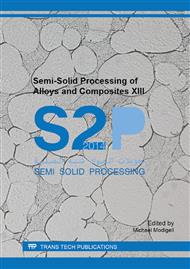p.265
p.274
p.281
p.286
p.294
p.302
p.312
p.318
p.325
THINCASTTM; Providing Strong, Lightweight Castings for Automobiles and Other Applications
Abstract:
Aluminium Rheinfelden has improved the competitiveness of semi solid processing by developing a casting process & alloy combination that is capable of ultra thin, ultra light parts having attractive engineering properties without need for full heat treatment. The THINCASTTM rheocasting process, together with Rheinfeldens Magsimal-59 alloy has been demonstrated capable of producing moderate sized castings with only 1-2 mm wall sections, thus providing a 30-50% reduction in traditional-process part weight. THINCASTTM can be adapted to a variety of die casting machines and will enable competitively improving the quality of conventional high pressure die castings as well as creating entirely new applications.
Info:
Periodical:
Pages:
294-301
Citation:
Online since:
September 2014
Authors:
Keywords:
Price:
Сopyright:
© 2015 Trans Tech Publications Ltd. All Rights Reserved
Share:
Citation:


